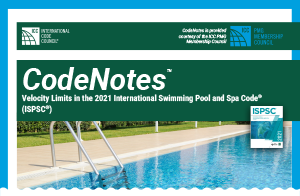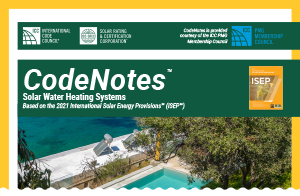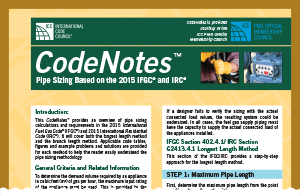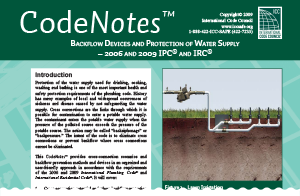
PMG CodeNotes™
CodeNotes are a part of the ICC PMG Membership Council's commitment to providing informative code support documents to serve the needs of plumbing, mechanical and fuel gas professionals. Topics include backflow devices and protection of water supply, gas pipe sizing based on the IFGC and IRC, and bonding of corrugated stainless steel tubing gas piping system.
Click below to view free copies, courtesy of the ICC PMG Membership Council.
2021 Code Cycle
This CodeNotes™ will focus on why complete combustion of fuel gas is essential for the proper operation of gas fired appliances and the methods for supplying all outdoor air.
This CodeNotes™ will focus on the Indoor Combustion Air methods in Section G2407.5 (304.5) of the International Fuel Gas Code (IFGC®).
This CodeNotes™ provides cross-connection scenarios and backflow prevention methods and devices in an organized and user-friendly approach in accordance with the requirements of the 2021 International Plumbing Code® (IPC®) and International Residential Code® (IRC®).
This CodeNotes™ provides an overview of the International Residential Code (IRC®) limits on the amount and location of bored holes and notches in dimension lumber. The purpose of these requirements is to maintain the structural integrity of wood framing.
This CodeNotes™ provides an overview of Rainwater Harvesting Systems as explained in the CSA B805/ICC 805-2018 Standard and how it is used for regulating the materials, design, construction, and installation of systems for rainwater collection, storage, treatment, and distribution of non-potable water.
This CodeNotes™ provides an overview of fuel gas pipe sizing calculations and requirements in the 2021 International Fuel Gas Code® (IFGC®) and 2021 International Residential Code (IRC®). It will cover both the longest-length method and the branch length method. Applicable code tables, figures and example problems and solutions are provided for each method to help the reader easily understand the pipe sizing methodology.
This CodeNotes™ provides an overview of the velocity limits noted in the 2021 International Swimming Pool and Spa Code® (ISPSC®). Velocity is used to help designers select the minimum pipe size for the design flow rate for a specific application. Improperly designed systems lead to highly inefficient systems creating high pressure, excessive noise, vibration, and potentially decreased equipment life.
Fuel gas plays an integral role in day-to-day life in the United States. This CodeNotes™ will review some of the major code requirements that are found in the 2021 IRC® and the 2021 IFGC® for underground fuel gas piping.
Air admittance valves (AAVs) are devices that were created to solve a problem with the conventional open pipe venting design and can serve as a vent for drainage waste and vent (DWV) systems in lieu of open pipe vents. This edition of CodeNotes provides the reader with an understanding of the IPC and IRC requirements on the installation of these valves.
This CodeNotes™ addresses the important code provisions associated with the use of air admittance valves on individual vents, branch vents, and circuit vents.
Solar water heating systems provide an efficient way to meet hot water loads in most climates. Unlike photovoltaic (PV) systems that generate electricity, most solar water heating systems directly heat fluids using solar energy. Fluid flows through outdoor solar thermal collectors where it is warmed by the sun.
This CodeNotes™ provides a description of the most common solar water heating systems used for residential and small commercial applications along with suggestions for inspecting them in accordance with the requirements found in 2021 I-Codes®.
The 2021 IPC and IRC recognize various methods of pipe restoration that include the relining of existing building sewer and building drainage piping to address the failing infrastructure of the built environment. Pipe relining processes are suitable for the repair of piping when it is acceptable for the relined piping to be of the same nominal size as the existing piping.
This CodeNote covers the process referred to as the “fold and form pipe (FFP)” method of pipe restoration for relining of building sewers and building drains found in the I-Codes. These items are mentioned in Section 717 of the 2021 IPC and Section P3011 of the 2021 IRC.
The 2021 IPC recognizes various methods of pipe rehabilitation that include the relining of existing building sewer and building drainage piping to address the failing infrastructure of the built environment. Pipe relining processes are suitable for the repair of piping when it is acceptable for the relined piping to be of the same nominal size as the existing piping.
This CodeNote covers the process referred to as the “cured in place pipe (CIPP)” method of pipe rehabilitation for relining of building sewers and building drains found in Section 718 of the 2021 IPC.
Trenchless technology by pipe bursting typically yields the largest increase in hydraulic capacity of any of the trenchless sewer rehabilitation methods. Therefore, pipe bursting might be especially applicable to projects that require maintaining or increasing the size of the current pipe as well as replacing defective pipe.
This CodeNotes™ addresses the important code provisions associated with the replacement of underground building sewers and building drains. These items are mentioned in Section 716 of the 2021 IPC and Section P3010 of the 2021 IRC.
The water heater installed in a home can be a ticking time bomb if not installed correctly or maintained properly. A water heater temperature and pressure relief valve is an important safety device for water heaters as well as the water distribution system to which it is connected. Any water discharge from the relief valve is an indication of an underlying problem.
This CodeNotes™ addresses the important code provisions associated with the relief valve. These items are mentioned in Section 504.6 of the 2021 IPC and Section P2804.6.1 of the 2021 IRC.
Compartmentalizing a building with fire-rated separations like fire walls, fire barriers, fire partitions, smoke barriers and smoke partitions is a critical feature of an effective fire protection system. When penetrating these walls or partitions with the ductwork of the heating, ventilation, or air conditioning (HVAC) system, the integrity of their ratings are sustained by the use of fire dampers, smoke dampers, or combination fire-smoke dampers.
This CodeNotes highlights the various types of dampers and their uses to provide an effective fire protection system.
Press-connect fittings are designed to create tubing and piping joints and are an alternative joining method that does not reduce the wall thickness of the tubing or pipe like traditional threaded joints do. Additionally, the installation of press-connect fittings does not require a heat source that traditional joining methods such as soldering, welding, or brazing do. With a press-connect joint, a pressing tool is used, in conjunction with a specifically sized jaw or ring to press specially designed press-connect fittings, to join pipe and tubing.
The permanent bonding of non-arc-resistant (yellow) CSST piping systems directly to the grounding electrode system of a structure serves to lower the voltage build-up on the CSST caused by unintentional energizing from outside sources such as lightning strikes. CSST manufacturers also produce a more robust, arc-resistant, (black) jacket system that does not require direct bonding to the grounding electrode system.
This CodeNotes highlights the steps, hardware and practices needed for the successful electrical protection of the CSST gas piping system using both products.
The design of exhaust systems is extremely important to the occupants of a building. There are specific occupancies and activities that have the potential for introducing hazardous substances into the indoor environment. Nail salons are one such occupancy.
This edition of CodeNotes provides the reader with an understanding of the requirements for an exhaust system for manicure tables and pedicure stations.
The International Swimming Pool and Spa Code® (ISPSC) requires construction documents, engineering calculations, diagrams and other such data be submitted in two or more sets with each application for a permit. When the work is of a “minor nature,” either in scope or needed description, the code official may use his or her judgement in determining the need for a detailed description of the work.
This CodeNotes™ lists important information based on the 2021 ISPSC and is provided as a guide for state and local jurisdictions for plan submittals of residential swimming pools and spas.
Where equipment and appliances requiring access are installed on roofs and elevated structures, safety for workers performing maintenance is a top concern.
This CodeNotes™ addresses the safety of occupants in buildings, and provides for protection for service and inspection personnel based on the 2021 International Mechanical Code (IMC®).
2018 Code Cycle
Air admittance valves (AAVs) are devices that were created to solve a problem with the conventional open pipe venting design and can serve as a vent for drainage waste and vent (DWV) systems in lieu of open pipe vents. This edition of CodeNotes provides the reader with an understanding of the IPC and IRC requirements on the installation of these valves.
This CodeNotes™ addresses the important code provisions associated with the use of air admittance valves on individual vents, branch vents, and circuit vents.
The water heater installed in a home can be a ticking time bomb if not installed correctly or maintained properly. A water heater temperature and pressure relief valve is an important safety device for water heaters as well as the water distribution system to which it is connected. Any water discharge from the relief valve is an indication of an underlying problem.
This CodeNotes™ addresses the important code provisions associated with the relief valve. These items are mentioned in Section 504.6 of the IPC and Section P2804.6.1 of the IRC.
Solar water heating systems provide an efficient way to meet hot water loads in most climates. Unlike photovoltaic (PV) systems that generate electricity, most solar water heating systems directly heat fluids using solar energy. Fluid flows through outdoor solar thermal collectors where it is warmed by the sun.
This CodeNotes™ provides a description of the most common solar water heating systems used for residential and small commercial applications along with suggestions for inspecting them in accordance with the requirements found in the 2018 I-Codes.
The control of fire and smoke is a major concern in the International Building Code (IBC®) and International Mechanical Code (IMC®). This edition of CodeNotes provides the reader with an understanding of the detailed requirements on these issues from an overall building construction viewpoint. The IBC and IMC contain many requirements and construction techniques intended to limit or control the spread of fire and smoke within a building.
Firestopping is a Life Safety topic addressed in the International Plumbing Code, but only briefly. The bulk of this topic is addressed within the International Building Code. This edition of CodeNotes introduces the reader to what the building code and plumbing code requires, regarding firestopping.
This edition of CodeNotes discusses a new section that was added to the 2018 editions of the International Fuel Gas Code and the International Residential Code. It addresses arc-resistant CSST products.
2015 Code Cycle
The 2015 ISPSC® Residential Swimming Pool and Spa Permit & Plan Guidelines CodeNotes™ provides a guide for state and local jurisdictions for plan submittals of residential swimming pools and spas. The intent is to provide additional clarity for the installation of a residential swimming pool and spa.
Also available in Spanish.
Discusses revisions to the 2015 editions of the International Fuel Gas Code and the International Residential Code for requirements in the electrical protection of corrugated stainless steel tubing through an extra bonding connection.
Also available in Spanish.
This CodeNotes™ provides an overview of entry/exit requirements of the 2015 International Swimming Pool and Spa Code® (ISPSC®) as they pertain to permanent inground residential swimming pools.
Also available in Spanish.
This CodeNotes provides an overview of the velocity limits noted in the 2015 International Swimming Pool and Spa Code® (ISPSC®). Velocity is used to help designers select the minimum pipe size for the design flow rate for a specific application. Improperly designed systems lead to highly inefficient systems creating high pressure, excessive noise, vibration, and potentially decreased equipment life.
Also available in Spanish.
This edition of CodeNotes provides a description of the most common solar water heating systems used in residential and small commercial applications, and suggestions for inspecting them in accordance with the requirements found in 2015 International Codes®.
The 2015 CodeNotes will provide you with an overview of pipe sizing calculations and requirements in the 2015 International Fuel Gas Code (IFGC) and 2015 International Residential Code (IRC). The 2015 version has been updated with new graphics and include the latest code changes.
This 2015 CodeNotes will help you understand the importance of protecting the potable water supply, identifying potential threats and determining the appropriate backflow preventer. IPC Table 608.1/IRC Table 2902.3.1 (Application of Backflow Preventers) has been provided to assist the user in selecting a suitable method or device for the application.
Also available in Spanish.
2009 Code Cycle
This CodeNotes provides an overview of pipe sizing calculations and requirements in the 2009 International Fuel Gas Code (IFGC) and 2009 International Residential Code (IRC). It will cover both the longest length method and the branch length method. Applicable code tables, figures and example problems and solutions are provided for each method to help the reader easily understand the pipe sizing methodology.
This CodeNotes provides cross-connection scenarios and back flow prevention methods and devices in an organized and user-friendly approach in accordance with the requirements of the 2006 and 2009 International Plumbing Code and International Residential Code.






































